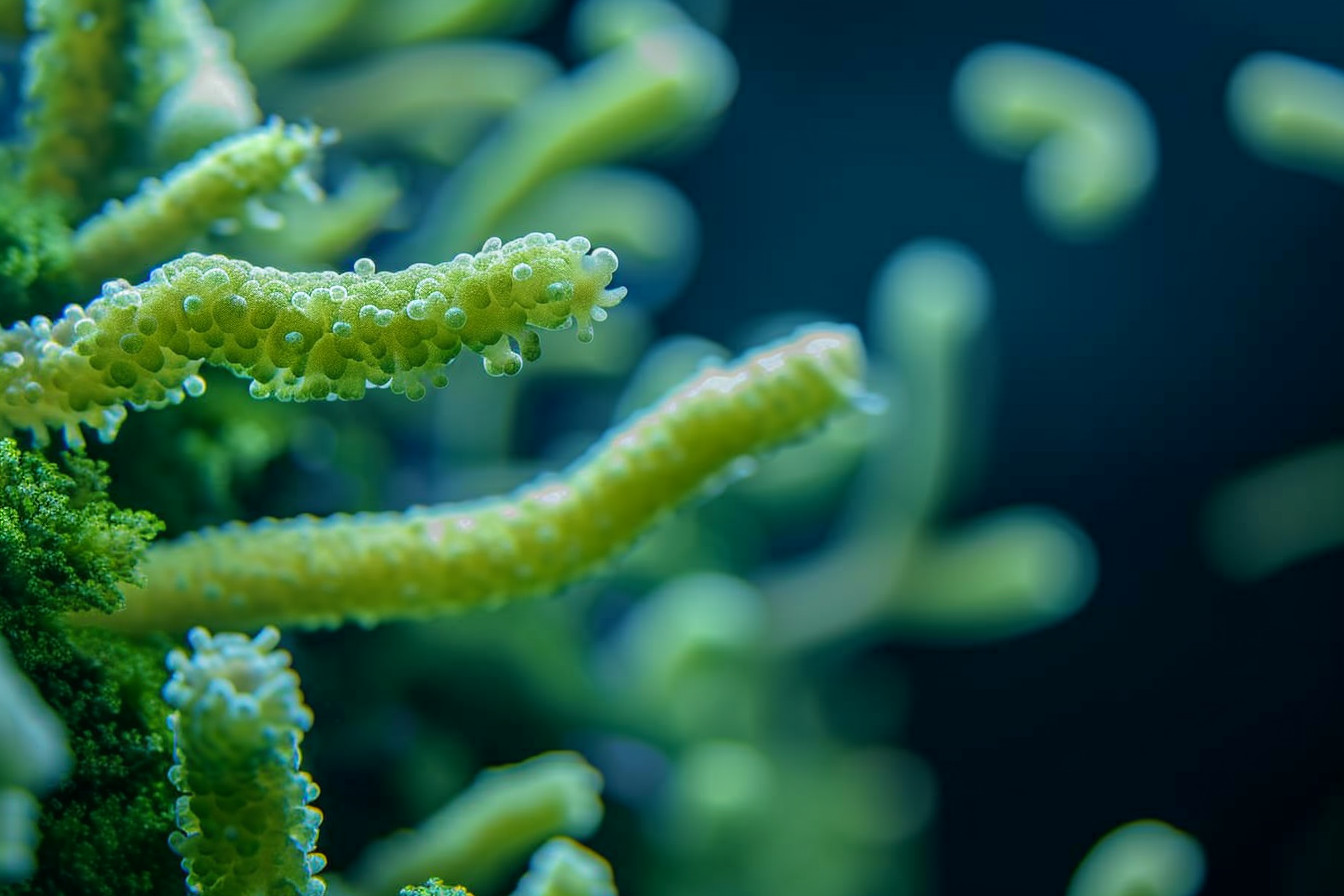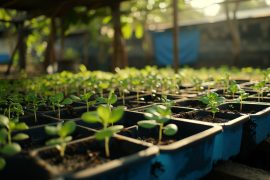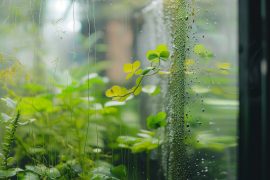I’ll never forget the moment I stumbled upon aquaponics. It was like finding a secret garden—a perfect blend of fish providing nutrients for plants and, in return, plants filtering water for the fish. But beneath this harmonious exchange lies an unseen hero: bacteria. You see, bacteria play a crucial role in transforming ammonia from fish waste into nitrates that plant roots can absorb as food—a process known scientifically as nitrogen cycling.
Diving deeper into how all these elements come together paints an inspiring picture of sustainability and environmental harmony. Think about it; there’s something incredibly peaceful knowing your dinner salad might have been grown with help from an ecosystem mimicking nature’s own processes—no chemicals or unnatural interventions necessary! And behind every leafy green thriving on top of calm aquatic environments is our microscopic friend, working tirelessly to make sure balance is maintained.
For me personally, diving into aquaponic systems wasn’t just about growing healthier foods; it was about discovering my connection with everything around me even more deeply. Thomas Merton’s contemplative silence speaks volumes if you’ve ever experienced floating silently onto a water surface, watching both worlds work under sunlight, rhythms connecting dots.
We often overlook the everyday hustle and mindless routines that pull us away, forgetting simple yet majestic circles. Life revolves within gardens, whether earthbound, sky-high, or nurturing, sustaining, preserving elemental truths, always benevolent bacteria, ensuring the cycle continues unbroken.
Understanding the Aquaponic Ecosystem
Delving into aquaponics, is like striking a perfect harmony between water life and plant cultivation. Think of an aquaponic system as nature’s own little symphony: fish, plants, and bacteria, all living together in one closed-loop ecosystem, each playing their crucial part. The beauty here? It mimics natural aquatic ecosystems, but right in your backyard or even inside your home.
Now let me break down this intriguing world where water flows from the fish tank to a filtration unit. Hey presto! This isn’t any ordinary filter; it’s bustling with hardworking nitrifying bacteria that take what we’d consider waste (ammonia) and transform it into nitrate, basically plant food.
Then come our green buddies, soaking up these nutrients directly from the water, which not only feeds them but also keeps our finned friends’ environment clean by purifying the backflowing H2O.
But how do those tiny, unseen heroes fit into an aquaponic setup? Picture microscopic transformers pulling off some clever chemistry tricks without needing any goggles or test tubes!
Thanks to bacteria such as Nitrosomonas europaea turning ammonia (NH3) released by fish through excretion or intake overflow into nitrites (NO₂⁻), followed closely behind another group represented primarily by Nitrobacter: converting said nitrites finally to nitrates (NO₃⁻). These are far less harmful to aquatic inhabitants while being just fabulous for growing happy, healthy veggies above!
All about numbers, you say?
| Bacteria Type | Conversion |
|---|---|
| Nitrosomonas | Ammonia → Nitrite |
| · Nitrobacter & Friends · Nitrite → Nitate |
Getting technical is pretty neat sometimes, especially when piecing out how things tick, eh?
The Importance of Bacteria in Aquaponics
When diving into aquaponics, there’s a hidden world that does the heavy lifting without any fanfare. It’s all about bacteria. These tiny microorganisms are powerhouses, turning waste into gold—well, not literally, but pretty close if you’re talking plant nutrients!
You’ve got your fish doing their thing swimming around; they eat and then produce waste. In an ordinary setup, this would be kind of a problem, but here’s where our microscopic heroes step up to bat.
Nitrogen is essential for plant growth, but guess what? Fish waste isn’t readily available in that form. Plants can use That’s right, folks, we’ve hit the part where science and magic happen. Nitrifying bacteria convert ammonia from fish poo first into nitrites, then nitrates. This transformation is nothing short of vital, creating a lush green environment where plants thrive.
But wait—it doesn’t stop with nitrogen transformations. Another group steps onto the field. Denitrifying bacteria work under low-oxygen conditions. They take care of excessive nitrates, cleaning up water as they go through. Their process ensures the system stays balanced, prevents algae blooms, and simply makes sure everything remains healthy.
The effectiveness of these bacterial interactions isn’t just lucky guessing. There have been countless studies showing how crucial a balanced microbial community is to successful aquaponic systems. Let me break down some numbers:
| Component | Impact |
|---|---|
| Ammonia conversion rate | Increases plant growth speed |
| Balance between types of bacteria | Reduces the need for chemical additives |
What ties all this together? Though it goes beyond chemistry or formulas, Sure, understanding those elements matters, yet at its core, gardening, particularly when venturing into realms like aquaponics, becomes an expressive art form here amidst water flows and leafy greens.
One finds tranquility connecting with nature on such foundational levels as learning, recognizing, and appreciating even the smallest contributors, like our invisible bacterial friends, opening us up to deeper harmonies within gardening spaces.
Such moments bring forth reflections on interdependence and life cycles. Energizing one to see beauty, simplicity, and complexity intertwined Reach out next time you’re near your garden, whether it’s a traditional soil-based or innovative aquatic venture. Whisper ‘thank you’ because now we know how much depends on unseen processes beneath visible surfaces.
Nitrogen Cycle in Aquaponics
Diving into the world of aquaponics, it’s fascinating to see how nature’s processes get mirrored on a smaller scale. With fish and plants living together harmoniously, there’s an invisible hero at work: bacteria! Yeah, you heard that right. These tiny warriors play a crucial role in converting waste products into something incredibly valuable for plant growth: nitrogen.
So here’s the deal with the nitrogen cycle in aquaponics: It starts when our finned friends produce waste or direct by-products that enter the water from uneaten feed. This might seem like a problem at first glance, but stay with me because this is where things start getting interesting! Ammonia, which can be harmful, is produced through these wastes. But fear not—certain beneficial bacteria are all about transforming this ammonia into nitrites.
Now I know what you’re thinking… “Aren’t nitrites bad too?” And yes, they are if left unchecked, but stick around because another group of good-guy bacteria enters stage left to convert those nifty nitrites into nitrates, which—drumroll, please—serve as fantastic nutrients for our leafy roommates above water!
To give you some perspective, let me throw out some numbers:
- In optimal conditions, most systems will fully process toxic compounds within 2–3 weeks.
| Week | Process |
|---|---|
| 1 | Ammonia accumulation begins |
| 2 | Nitrite peak |
| 3 | Conversion to Nitrates |
This constant cycling ensures toxins don’t pile up, making sure both parties involved live their best lives symbiotically without any buildup of nasty stuff, keeping everything healthy and balanced just as Mother Nature intended.
But wait—there’s more science fun beyond mere conversions. Growing your own greens, feeding fish, and observing microscopic interactions every day turns educational. Who knew learning could feel so tranquil? There are personal accounts galore online showcasing successful setups. Yet each story resonates with similar sentiments. appreciating small cycles connecting us back to nature reminds us that simple solutions often lie deeply rooted beneath the surface.
Beneficial Bacteria in Aquaponic Systems
Diving into the world of aquaponics, it’s fascinating to see how much life thrives not just above water but within. At their core, beneficial bacteria play a huge role in keeping these ecosystems flourishing. I’m talking about those tiny, unseen heroes that make aquaponic systems tick.
One star player is Nitrosomonas; this little bug converts ammonia from fish waste into nitrites, something slightly less toxic and an integral part of the nitrogen cycle. Then there’s Nitrobacter chipping away at its own job by turning those nitrites into nitrates—plant food! So essentially, you’ve got a setup where fish support plants while getting cleaner water as their reward—a win-win if ever there was one.
Let me paint you a picture with some numbers:
- Roughly 60% reduction in the need for direct plant watering
- Up to 90% more efficient use of water compared to traditional farming methods
This isn’t just eco-friendly; it’s like nature itself designed the perfect recycling program!
Ever heard stories about people finding unexpected friendships? That’s what’s going on here—fish and plants unknowingly teaming up thanks to our bacterial buddies ensuring everything works smoothly under (and above) the surface.
But don’t take my word alone for it—I’ve had first-hand experience watching lettuce roots grow plump and healthy, submerged directly next door to tilapia clusters doing their thing—all amidst waters teeming invisibly with beneficial bacteria hard at work.
The beauty lies not only in what we can observe visually: lush green leaves or colorful fish making rounds but also in appreciating this intricate balance maintained silently below by countless microorganisms day after bustling day—it truly exemplifies harmony between living beings without words spoken—a silent dance guided strictly by mutual benefit principles ingrained deeply across all forms of life, including microscopic ones found bubbling cheerfully within your homegrown aquaponics system!
Final Thought
Wrapping up our deep dive into the world of aquaponic ecosystems and their bacterial inhabitants, I can’t help but feel a profound sense of appreciation for these tiny yet mighty creatures. Bacteria often get a bad rap as being harmful or unwanted, but in the context of an aquaponic system, they’re nothing short of miraculous workers.
What’s become crystal clear through exploring this subject is that bacteria play a pivotal role in ensuring the health and efficiency of aquaponics. They are the unsung heroes quietly working behind the scenes to convert fish waste into vital nutrients for plants—talk about teamwork! Without them doing their bit, we wouldn’t see such thriving aquatic gardens at all.
Here’s what grabbed my attention most:
- Bacteria facilitate nutrient cycling, transforming ammonia from fish waste into nitrates, which plant roots happily absorb.
- This process not only keeps our finned friends healthy by cleaning water but also acts like organic fertilizer magic, making sure those greens grow lushly strong without synthetic additives.
And it doesn’t stop there; maintaining balance within your ecosystem becomes far simpler with beneficial bacteria on board since they regulate key parameters, keeping both flora and fauna content!
Another realization was just how scalable, adaptable systems are based around bacterial activity—from small home setups to sprawling commercial operations, everyone benefits tremendously. Understanding how nurturing microbial life forms part of the equation really opens doors to the vast potential for sustainability, productivity, and collaboration between different species under one roof (or sky).
The journey has been enlightening and underscored the importance of having a mindful approach when setting up and operating any kind of garden, particularly one that harnesses power from nature, does the heavy lifting, and takes a moment to thank every microscopic organism out there for contributing unseen ways to creating harmonious environments. flourish; let’s continue learning, growing together, and embracing the complexities and rewards gardening offers to the fullest!







